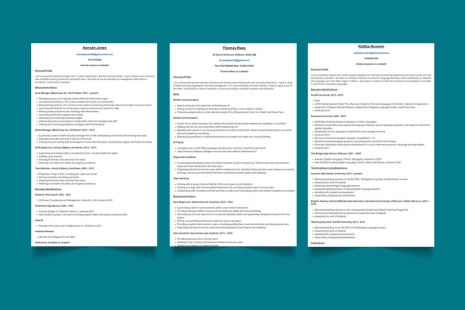Introduction to Video CVs
A video CV can show your creativity to employers and help you stand out from the crowd. Learn how to create your own video CV.
A video CV is a short recording, usually 1 to 3 minutes long. It highlights your skills and experience but also allows you to show your personality to employers.
You might use a video CV to apply for work in the media, in marketing and sales or in some creative roles. But you can sometimes use a video CV in other work areas too.
It’s important to check whether your prospective employer expects video CVs.
In some cases, a video CV will help you stand out. But this won’t work with an employer that prefers written CVs or application forms.
There are smartphone apps that let you film, edit, upload and share videos. If you feel confident enough, you could create your video CV using your phone.
You might prefer to use proper video equipment, including a camera, tripod and video editing software. This will give your video a really professional look.
If you don’t have good editing skills, you might want to ask for help.
You can either upload your video CV to a website like YouTube or email it directly to employers.
Ensure that the video is “unlisted” and not public. This means that you can send a link to it to employers, but it is not available to anyone else.
Also remember to check that any employer you send your video to is a genuine employer.
Preparing for your video CV
Before you film, do the following:
- Plan what you want to say about yourself and write it in a script. This will mean you don’t miss out anything important
- As you plan, imagine the different scenes you want to include. Think about what you want to show visually for each one
- Learn your script so you don’t have to keep looking at notes when you film. It’s fine not to follow the script exactly, which will make you sound more natural. However, your script will keep you on track and sounding professional
- Choose a quiet, well-lit space to film in. Make sure the area is tidy and uncluttered
- Only use props where appropriate
- Dress like you would for an interview. If you have a sense of what the employer might expect, try and be as close to that as possible
- Set up your equipment and test it to make sure it works
Filming your video CV
When you’re ready to film:
- Ensure you’ve rehearsed your script a few times so that you’re used to saying it aloud. Practise makes perfect
- Try out different shots and camera angles for variation
- Film the video a few times so that you’ve got lots of material to work with when editing
Editing your video CV
When you’ve finished filming:
- Take out shots that didn’t work. Include only the best ones
- Reorder and tighten up your footage where you need to
- Add visual and sound effects if they will give it a stronger impact. You could have background music or pointing to text as it appears
Sharing your video CV
Once you’ve done your video CV, you need to decide how to share it.
You can email it to employers. But, uploading it to a video sharing platform like Vimeo or YouTube will make it easier for employers to find it.
Remember to publish your video as unlisted so that only people you choose can watch it.
If you are emailing it, look up the employer online to make sure it is a genuine employer.
Doing the above will protect your personal information
Once online, you can put links to your video CV on your social media channels.
What to include in your video CV
The structure of a video CV is more flexible than for a written CV. Main elements to include are below.
Beginning:
- Introduce yourself
- Explain why you’ve created the video
- Tell the employer why you’re the right person for the job
Middle:
- Talk about relevant skills and experience you have and include your unique selling points
- You could use clips and onscreen graphics or slideshows to evidence your skills
- Show examples of your work from your portfolio
- You could go for a question and answer format or a timeline of experience
- You could show a project you’ve done in detail if that’s more relevant
Ending:
- Summarise the main skills or attributes you’ve shown them
- State why you’re the best person for the job
- Thank the employer for watching
- Include your contact details
- Link to online profiles such as your LinkedIn, your website or e-portfolio
Video CV top tips
Before you decide to create a video CV:
- Research the company to find out if they would expect a video CV from you. If they have a standard application form instead, put your efforts in to that
- Consider if a video CV would show you in the best light. If you’re awkward in front of a camera, it might not be the best way to show your best qualities
If you decide to create a video CV:
- Look online for example video CVs to inspire you. Don’t try to copy them
- Record the video several times until you are happy with it
- Be professional in what you say and how you look
- Think about how best to show off your skills. Be creative
- Keep it as short as possible and keep it relevant
- Get someone to watch it and give you feedback
Get more help and support
The Skills to Succeed Academy is an online learning tool where you can learn more about building CVs, interview preparation and much more. Visit our Skills to Succeed page to find out how to register.
If you need advice or support to create your CV, contact us.
You might also like

Learn how to create your CV, find out what to include in your CV, view our free CV templates, and download our guide to CV writing.

Learn about the different ways you can format a CV.

Find out how to do a good interview using the STAR technique, get interview advice and preparation tips.

